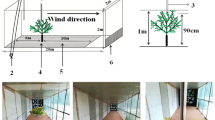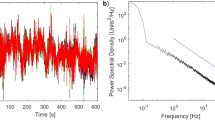Abstract
DAVIES has demonstrated1 in a wind tunnel that Myzus persicae Sulz. did not take to flight in wind speeds greater than 3.75 m.p.h. His experiments, and field observations by other research workers, have given rise to a generalization that aphids do not take off in wind velocities greater than 5 m.p.h.2.
This is a preview of subscription content, access via your institution
Access options
Subscribe to this journal
Receive 51 print issues and online access
$199.00 per year
only $3.90 per issue
Buy this article
- Purchase on Springer Link
- Instant access to full article PDF
Prices may be subject to local taxes which are calculated during checkout
Similar content being viewed by others
References
Davies, W. M., Ann. App. Biol., 23, 401 (1936).
Johnson, C. G., Biol. Rev., 29, 87 (1954).
Haine, E., Anz. f. Schädlingsk., 27, 55 (1954).
Johnson, B., Nature, 172, 813 (1953).
Author information
Authors and Affiliations
Rights and permissions
About this article
Cite this article
HAINE, E. Aphid Take-off in Controlled Wind Speeds. Nature 175, 474–475 (1955). https://doi.org/10.1038/175474a0
Issue Date:
DOI: https://doi.org/10.1038/175474a0
This article is cited by
-
Interactions between diurnal winds and floodplain mosaics control the insect boundary layer in a river corridor
Aquatic Sciences (2023)
-
Cereal aphid movement: general principles and simulation modelling
Movement Ecology (2013)
-
10.1007/BF00334030
CrossRef Listing of Deleted DOIs (2011)
-
Aphid-transmitted potato viruses: The importance of understanding vector biology
American Journal of Potato Research (2002)
-
World literature
International Journal of Bioclimatology Biometeorology (1959)
Comments
By submitting a comment you agree to abide by our Terms and Community Guidelines. If you find something abusive or that does not comply with our terms or guidelines please flag it as inappropriate.



